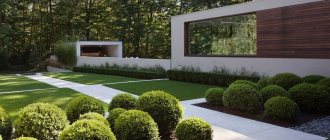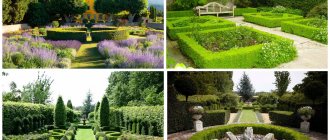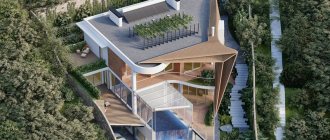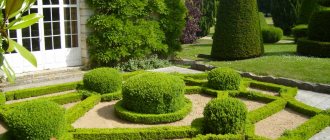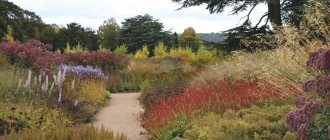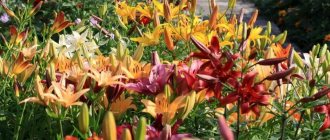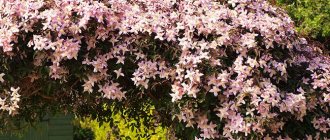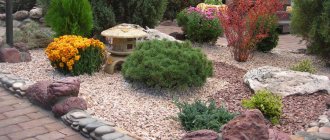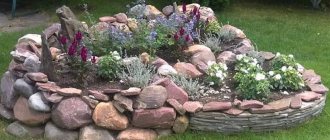Landscape style strives for naturalness. He uses the same means of expression as nature itself. These are the arbitrary outlines of the crowns of trees and shrubs, variegated combinations of colors, the dense greenery of lawns, and a complex perspective formed by an unusual topography. The formation of the landscape style began two centuries ago in England, and over time, several independent directions appeared “within” it:
- English - imitates natural landscapes, but is quite strict;
- eco-gardens - the most accurate recreation of the natural landscape with minimal impact on the environment;
- NaturGarden is a newly developed concept of deliberate naturalness, carelessness, with the help of which the beauty of each plant is revealed;
- romanticism - traditional landscape gardens, complemented by a large number of small architectural forms in the classical style.
Over time, many countries have developed their own understanding of landscape style. In France it is Provence, in America it is country. Moreover, all directions have a number of common features: the absence of clear lines, strict geometry, smooth planes, and symmetry.
Features of landscape style
This design direction is also called the classic style; it does not require leveling the terrain; elevation changes are a natural phenomenon here. Therefore, landscape design involves preserving the natural environment with hills and ponds.
A landscape-style garden should look as natural as possible, but the plants and shrubs should be well-groomed and neat.
The paths and ponds here reflect an asymmetrical order Source seattlehelpers.org
When creating a project, it is important to think over a system of paths along which you need to move around the garden. A competent designer will skillfully arrange all these details and successfully place benches, fountains, outbuildings and picturesque flower beds on the site.
Landscape design project Source seattlehelpers.org
Important! To create a landscape direction, at least 12 acres of adjacent or dacha territory are required, since a small garden will not convey the full harmony of the landscape and will reflect only small details of the English style.
Features of landscape style in landscape design:
- Smooth lines with bends and branches for paths and paths. The banks of reservoirs should be just as natural. No strict symmetry or straight geometric lines.
- Architectural elements for organizing the exterior: gazebos, bridges fit harmoniously into the landscape without standing out from the general environment.
- antique statues is encouraged .
Landscape style in landscape design Source helionews.ru
- Flower beds and flower arrangements organically blend into the decor of the local area; their location is like a neat mound or a small lawn.
- Only natural materials for organizing the exterior. No - plastic. Clay, wood, stone, iron are the main tools for creating a beautiful and harmonious appearance of the site.
- Plants and shrubs characteristic of the area where the house or cottage is located. Unacceptable - trees of tropical origin, herbs and flowers in the middle zone of the northern hemisphere.
Floral arrangements blend seamlessly into the setting Source seattlehelpers.org
- Natural range of plants . Muted shades: grass green, purple, silver white, light pink. Variegated colors will bring discord to the English style.
Muted shades in landscape style Source benimmulku.com
On a note! It is unacceptable to artificially form the crowns of trees and shrubs, trimming them to geometrically even shapes, or create topiaries. It is enough to let them grow freely, only slightly adjusting the process of their growth. This includes the usual sanitary crown pruning and thinning.
Landscape style does not imply neglect of plants. Therefore, mowing the lawn, caring for flowers, pulling out weeds and other household chores must be done regularly. Except that it would require less time and effort if you had a modern landscape design in an avant-garde style.
In this style there is no central point from which a panorama of the entire garden could open. It can only be partially seen. But with each transition from one place to another, a picturesque picture opens up to the gaze of the “traveler” through the area.
Landscape style does not imply neglect of plants Source housetipster.com
See also: Catalog of companies that specialize in landscaping work on sites.
How to recreate the beauty of nature: rules and recommendations
When creating this style, pay attention to the numerous landscapes created by nature.
The rules of the English style require a harmonious arrangement of plantings. Higher elements should be located next to the middle ones and then smoothly move to the lowest growing ones. Tiered arrangement of plants: from tree to shrub, from flowers to lawn is the key to success.
It is important! Despite the fact that paths require smooth bends and tortuosity, this does not mean that the paths from the house to the outbuildings should wind around the entire garden. Convenient location of all elements, first of all.
When constructing paths, flagstone stone and wooden beams are used, imitating a naturally occurring path Source yandex.ru
This style does not tolerate “thickened” plantings, as well as the mandatory use of every extra square meter. Space and freedom are the motto of nature.
There is no need to use luxurious fountains and alpine slides if the site has a natural meadow with flowers and a pond with water lilies. Maximum pristineness of the garden, combined with masking the “shortcomings” of the territory, is only welcome.
Pond with water lilies in landscape style Source saveoursodus.com
Eastern garden
When we talk about an oriental garden , we most often mean the famous Japanese gardens or the Chinese version. The task of both is to reproduce the surrounding world in miniature in a small area. Moreover, the garden should look absolutely natural, and the means for creating it are not very diverse. Natural elements are combined here: stones, water, flowers and trees. The emphasis is on rocks and water, and only plants that grow in the area are used. In the eastern garden there is almost no lawn, and flowers are used very rarely.
Each object, each of its elements carries its own deep philosophical meaning, which is closely intertwined with the manifestations of our complex and multifaceted world. The elements of the garden are arranged relative to each other in such a way as to achieve harmony, balance and proportions, which are the basis of life. And such a garden can be read like hieroglyphs. Stones symbolize mountains, streams symbolize rivers, wavy patterns on pebbles symbolize waves, dwarf trees symbolize spreading crowns. Let us give a conditional example so that the depth of the philosophy of the eastern garden is clear. Imagine that you are looking from above at a three-dimensional architectural model of a city with its houses, streets, rivers and bridges. And then on this layout we will replace houses with stones, streets with paved paths, rivers with streams, bridges with groups of stones across a stream or stone bridges. We use stone lanterns to mark the east and west - where the sun rises and sets. We will give a special position to stones of different shapes and sizes and call one of them “skyscraper”, another “shopping center”, and the third “our home”. And, contemplating this landscape “city”, imagining what a happy life could be there, we will feel peace, harmony and unity with nature.
It is almost impossible to recreate a real oriental garden in our conditions. In our conditions, you can make a garden in an oriental style.
Selection of plants on the site
To create a landscape style, unpretentious plants are most often used. Flowers include mallow, irises, and pansies. Also widely used directly near buildings and not far from them in flower beds are crocuses and tulips, and delphinium.
Unpretentious plants are used in landscape style Source pinterest.com
Water
Water is not a necessary element of landscape style, as in Japanese and Chinese gardens. But the presence of an artificial or natural waterfall, pond and small river makes the site even closer to nature. The most harmonious work of a designer or gardener is considered to be the one whose hand is not visible. A kind of illusory nature of natural chaos. At first glance, it seems that no one takes care of such a garden, but this is not so. Moving along the original path that leads to a bridge over a stream, the view reveals a hilly terrain, a mysterious corner of the garden, a romantic gazebo, etc. Everything should look as natural as possible.
Chinese style in landscape design
Along with the English style, other types of landscape design, similar to landscape ones, have become quite popular. One of them is the Chinese style.
This direction is based on the Eastern worldview, according to which everything in nature is permeated by qi energy. Its flows circulate freely only along “miraculous” contours that do not have straight lines, sharp angles or symmetry.
Chinese style in landscape design Source sohu.com
Dutch garden
The Dutch garden differs from its European neighbors, firstly, in its small size, because... Holland has a low-lying terrain, and the land there is valued dearly, and secondly, for its lack of pomp. The house divides a plot of several acres into 2 unequal parts: a small front garden with bright flower beds in front of the house and an area for other plantings and household needs behind the house. Along with extraordinary neatness, lush vegetation, hedges and bright flower beds, an atmosphere of comfort and isolation reigns here.
Utensils and agricultural implements that have gone out of use are often used as small architectural forms: an old cart with flowers, a surviving wicker basket, decorative wells, mills, etc.
